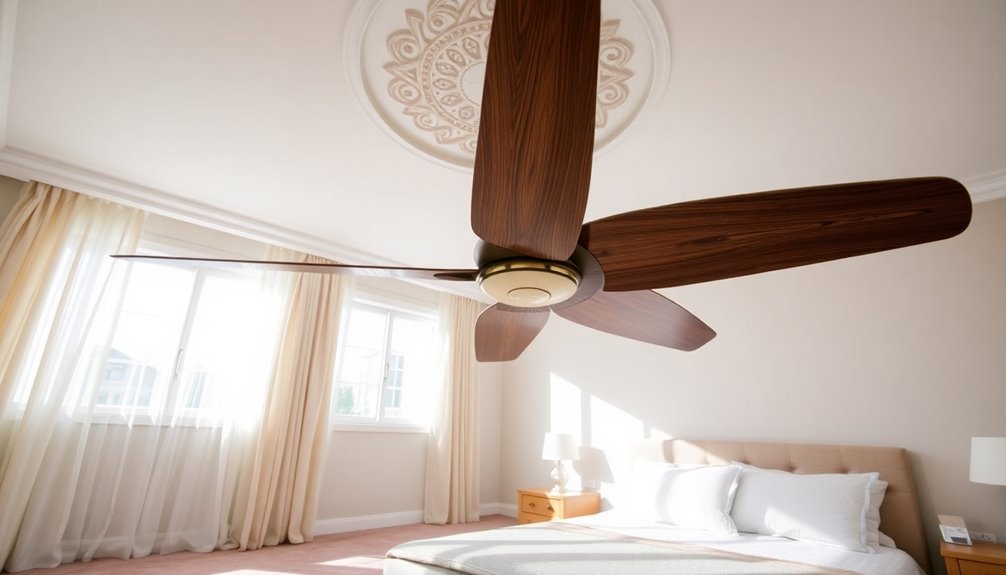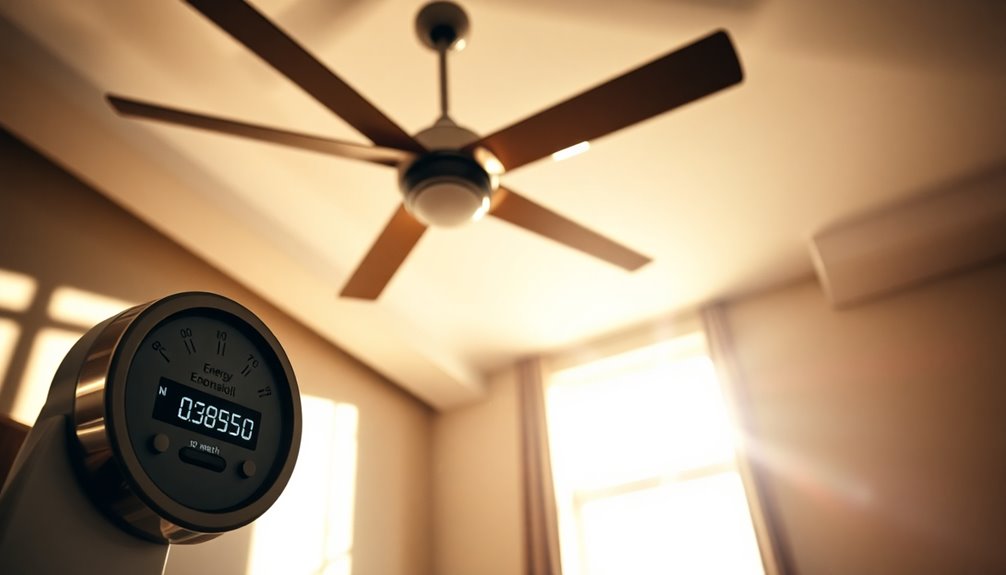To determine how big of a ceiling fan you need, start by measuring your room's square footage. For small rooms (up to 100 sq ft), choose fans between 29-36 inches. Medium rooms (up to 400 sq ft) work well with 36-50 inch fans. If your ceiling is under 8 feet, opt for low-profile fans. For high ceilings, consider using a downrod for effective airflow. Additionally, factor in room purpose, any obstacles in the way, and desired cooling needs. The right fan size can truly enhance your comfort, and you'll discover more tips to perfect your choice.
Key Takeaways
- Measure the room's square footage by multiplying length and width to determine the appropriate fan size.
- Select fans based on room size: 29-36 inches for small rooms, 36-50 inches for medium rooms, and 50-71 inches for large spaces.
- Ensure fans are mounted at least 7 feet above the floor for safety and optimal airflow.
- Use low-profile fans for ceilings under 8 feet and downrods for ceilings over 9 feet to maintain proper height.
- Consider the room's purpose and cooling needs, as heat-generating areas may require larger fans for effective circulation.
Measuring Room Size

When you're ready to choose the right ceiling fan, measuring your room size is vital, as it directly impacts airflow and cooling efficiency.
Start by using a tape measure to capture the exact length and width of your room. To determine the square footage, simply multiply these two dimensions. For instance, if your room measures 12 feet by 15 feet, you've got 180 square feet to work with.
If you're dealing with an L-shaped room, don't worry. Just divide the area into smaller rectangular sections, calculate the square footage for each, and sum them up for the overall area. Knowing the total square footage helps you select the appropriate ceiling fan size for maximum airflow.
Also, remember to measure the height of your ceiling. The ideal height guarantees adequate clearance between the blades and the floor, which is critical for effective fan installation.
Keep in mind that if your room exceeds standard dimensions, you may need to evaluate specific placements or larger fan sizes to maintain adequate air circulation. Accurate measurements will make all the difference in creating a comfortable environment.
Choosing Fan Size

Choosing the right ceiling fan size is vital for maximizing airflow and comfort in your space. To determine the appropriate fan diameter, start by measuring your room size.
For small rooms up to 100 square feet, you should opt for ceiling fan sizes between 29-36 inches. If your room is medium-sized, up to 400 square feet, choose fans ranging from 36-50 inches for peak airflow. A 42-inch fan works well in spaces between 144 and 225 square feet, while a 52-inch fan is ideal for areas from 225 to 400 square feet.
For larger spaces over 400 square feet, large ceiling fans of 50-71 inches are necessary to guarantee adequate air circulation and comfort.
Remember that selecting the right size is important; an improperly sized fan can lead to poor air circulation and increased energy costs. By understanding ceiling fan sizing and the needs of your specific room size, you can effectively choose the right size to enhance your environment.
Prioritizing the correct fan diameter will help you enjoy a more comfortable atmosphere year-round.
Ceiling Height Considerations

Ceiling height plays an essential role in selecting the right ceiling fan for your space, as it directly affects both safety and airflow. Ideally, fans should be mounted at least 7 feet above the floor to guarantee ideal airflow and safety.
For ceilings under 8 feet, you should choose low-profile or flush mount fans to maintain proper clearance between the fan blades and the ceiling. This helps prevent any potential accidents while maximizing airflow.
If your ceiling height is between 8 to 9 feet, standard-mount fans are typically a good option, requiring a distance of 12-14 inches from the ceiling to the fan blades for effective airflow.
For high ceilings over 9 feet, you'll need to take into account downrod length to guarantee the fan hangs at around 8 feet from the floor. Remember to factor in any light kits attached to the fan, as they can impact the overall height and clearance requirements.
Downrod Length Selection

Selecting the right downrod length is essential for guaranteeing your ceiling fan operates efficiently and safely. If your ceiling height exceeds 9 feet, you'll need a downrod to lower the fan to an ideal height for airflow and clearance.
Typically, fan housings are about 8 to 12 inches tall, so you must factor this in when calculating your required downrod length.
To determine the appropriate length, subtract your desired fan height—generally 8 feet above the floor—from the total ceiling height, then add the height of the fan housing. For instance, if your ceiling is 10 feet high, you'll need a 12-inch downrod to maintain that 8-foot clearance from the floor to the fan blades.
Using reference charts can further simplify this process, providing recommendations for downrod lengths based on various ceiling heights. This way, you can guarantee proper fan placement, maximizing airflow and safety in your space.
Choosing the right downrod length not only enhances the performance of your ceiling fan but also contributes to a more comfortable environment in your home.
Additional Sizing Factors

Once you've determined the right downrod length for your ceiling fan, it's time to contemplate additional sizing factors that can greatly impact its performance.
First, consider the room's purpose and cooling needs. Heat-generating areas, like kitchens, may require larger or multiple fans to guarantee effective airflow.
Next, evaluate the room height. If your ceiling is lower than 8 feet, opt for low-profile fans to maintain adequate clearance. Conversely, higher ceilings often necessitate downrod fans to enhance air circulation.
Don't overlook the square footage of your space. If you have an irregularly shaped room, calculate the square footage of each section and add them together to find the appropriate fan size.
The fan's CFM (Cubic Feet per Minute) rating is essential, too. Confirm it aligns with your room size; higher CFM ratings are ideal for larger spaces.
Finally, assess any obstacles like beams or furniture that could disrupt airflow or compromise safety clearance.
Frequently Asked Questions
Is a 52 Inch Fan Too Big for a 12X12 Room?
Yes, a 52-inch fan's too big for your 12×12 room.
This size can create uncomfortable airflow and lead to poor air circulation, making the space feel overwhelming.
Ideally, you should use a fan between 36 and 50 inches for best performance.
A 42-inch fan would be perfect for your room size, enhancing cooling efficiency while minimizing energy costs and ensuring a comfortable environment without risking motor burnout.
What Size Room for a 52 Inch Ceiling Fan?
A 52-inch ceiling fan's ideal for rooms between 225 and 400 square feet.
If you've got a medium-sized bedroom or an open concept living area, this size will keep the air circulating effectively.
To guarantee it works best, calculate your room's square footage by multiplying length and width.
Remember to keep at least 8 feet of clearance between the floor and the fan blades for maximum airflow and comfort.
What Size Ceiling Fan for a 20X20 Room?
In a 20×20 room, you'll want a ceiling fan with a blade span of 52 to 60 inches for ideal airflow.
Imagine having a fan that circulates over 4,500 cubic feet of air every minute—it's like a rejuvenating breeze on a hot day!
A 56-inch fan fits perfectly, ensuring your space stays cool.
Just make sure to install it at least 7 feet above the floor for safe and effective air distribution.
How Do You Calculate the Size of a Ceiling Fan for a Room?
To calculate the size of a ceiling fan for your room, start by measuring its length and width to find the total square footage. Multiply those dimensions together.
For rooms up to 144 square feet, a 42-inch fan works well, while a 52-inch fan suits spaces between 225 and 400 square feet.
Don't forget to check the fan's CFM rating for adequate airflow efficiency, ensuring it cools your space effectively.
Conclusion
In choosing the right ceiling fan, you're not just enhancing comfort; you're also improving energy efficiency. Did you know that a properly sized ceiling fan can save you up to 40% on your cooling costs? By measuring your room and considering factors like ceiling height and downrod length, you can create a cozy atmosphere while cutting down on utility bills. So, take the time to find the perfect fit for your space—you'll feel the difference!









